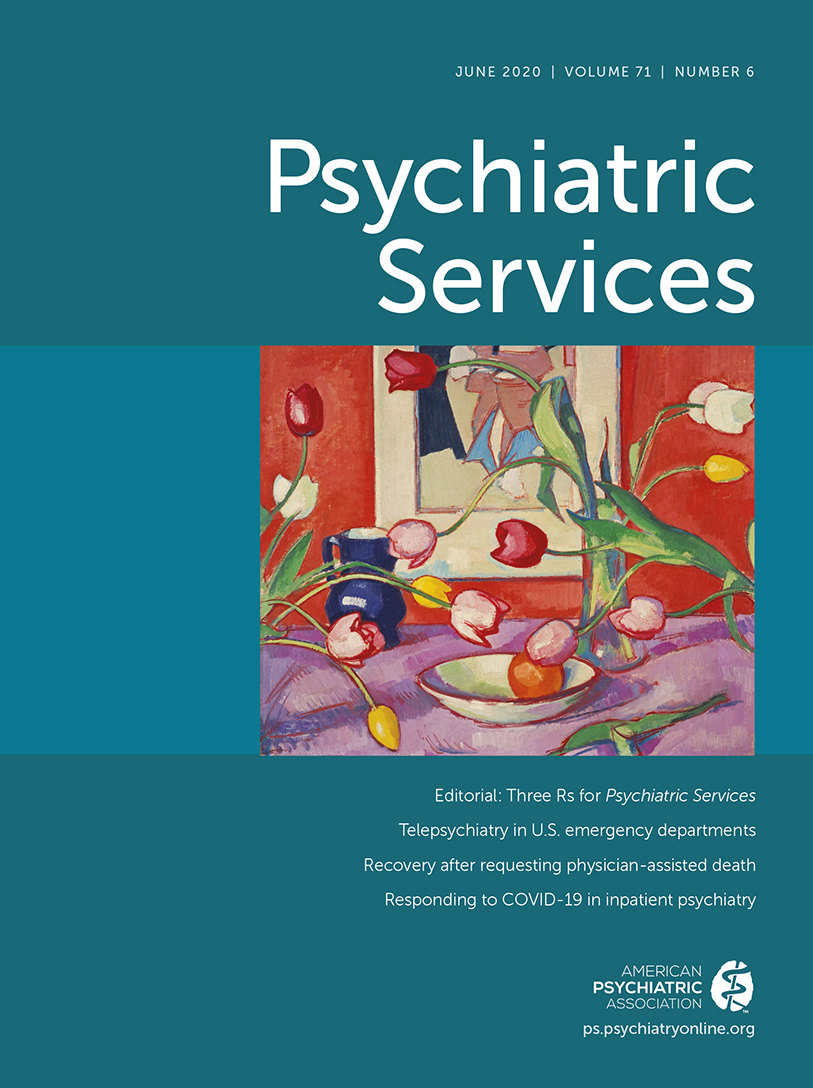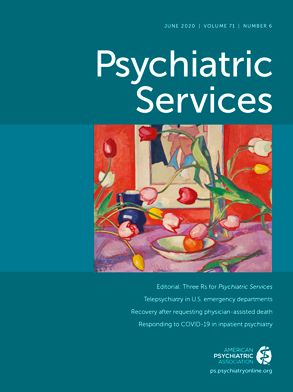Selection Into Mental Health Services Among Persons With Depression
Abstract
Objective:
Methods:
Results:
Conclusions:
HIGHLIGHTS
Methods
Data
Measures
Analyses
Results
| Medication only (N=371) | Counseling only (N=1,012) | Medication and counseling (N=2,786) | Total (N=4,169) | |||||
|---|---|---|---|---|---|---|---|---|
| Characteristic | N | % | N | % | N | % | N | % |
| Pathway into care | ||||||||
| Independent | 236 | 86.1 | 513 | 80.4 | 2,132 | 82.5 | 2,744 | 82.4 |
| Asked by someone | 58 | 12.2 | 104 | 14.5 | 350 | 12.5 | 517 | 12.8 |
| Ordered | 22 | 1.7 | 33 | 5.1 | 164 | 5.1 | 230 | 4.8 |
| Race-ethnicity | ||||||||
| Non-Hispanic white | 270 | 74.6 | 651 | 66.6** | 2,140 | 80.5 | 3,061 | 76.9 |
| Non-Hispanic black/African American | 26 | 7.1 | 105 | 10.3 | 196 | 7.2 | 327 | 7.9 |
| Latinx/Hispanic | 46 | 14.0 | 158 | 15.0 | 249 | 7.9 | 453 | 10.0 |
| Other | 29 | 4.3 | 98 | 8.1* | 201 | 4.4 | 328 | 5.2 |
| Age | ||||||||
| 18–25 years | 124 | 14.5 | 428 | 23.2 | 807 | 12.4 | 1,359 | 15.0 |
| 26–34 years | 63 | 13.6 | 218 | 20.6 | 578 | 15.5 | 859 | 16.4 |
| 35–49 years | 101 | 23.8 | 253 | 27.7 | 926 | 31.2 | 1,280 | 29.7 |
| 50–64 years | 59 | 34.3 | 94 | 23.5** | 362 | 29.6 | 515 | 28.7 |
| ≥65 years | 24 | 13.8 | 19 | 5.0** | 113 | 11.4 | 156 | 10.2 |
| Sex | ||||||||
| Male | 106 | 30.1 | 299 | 32.7 | 698 | 28.1 | 1,103 | 29.3 |
| Female | 265 | 69.9 | 713 | 67.3 | 2,088 | 71.9 | 3,066 | 70.7 |
| Residential area | ||||||||
| Large metro | 135 | 42.8 | 486 | 60.7* | 1,158 | 51.5* | 1,779 | 52.7 |
| Small metro | 146 | 41.4 | 364 | 28.7** | 1,029 | 32.5 | 1,539 | 32.5 |
| Nonmetro | 90 | 15.8 | 162 | 10.6 | 599 | 16.0 | 851 | 14.8 |
| Education | ||||||||
| Less than high school | 52 | 13.9 | 122 | 12.3 | 280 | 10.3 | 454 | 11.0 |
| High school graduate | 107 | 31.3 | 220 | 20.5 | 645 | 21.0 | 972 | 21.8 |
| Some college | 143 | 33.6 | 405 | 36.7 | 1,164 | 40.5 | 1,712 | 39.0 |
| College graduate | 69 | 21.2 | 265 | 30.5*** | 697 | 28.2 | 1,031 | 28.1 |
| Employment | ||||||||
| Employed full-time | 140 | 32.9 | 443 | 44.5* | 996 | 32.5 | 1,579 | 35.2 |
| Employed part-time | 72 | 17.6 | 243 | 20.1 | 508 | 14.2 | 823 | 15.8 |
| Unemployed | 31 | 6.1 | 62 | 5.1 | 188 | 4.7 | 281 | 4.9 |
| Not in labor force | 128 | 43.4 | 264 | 30.2 | 1,094 | 48.5 | 1,486 | 44.1 |
| Poverty level | ||||||||
| <100% FPL | 88 | 22.1 | 254 | 23.7 | 684 | 21.6 | 1,026 | 22.1 |
| 100%–199% FPL | 98 | 22.6 | 243 | 24.1 | 662 | 22.7 | 1,003 | 23 |
| ≥200% FPL | 185 | 55.3 | 491 | 52.2 | 1,414 | 55.8 | 2,090 | 54.9 |
| Health insurance | ||||||||
| No | 43 | 11.0 | 104 | 11.1 | 208 | 6.2** | 355 | 7.7 |
| Yes | 328 | 89.0 | 908 | 88.9 | 2,578 | 93.8* | 3,814 | 92.3 |
| Self-rated health | ||||||||
| Fair or poor | 136 | 31.4 | 505 | 43.5* | 998 | 30.5 | 1,639 | 33.5 |
| Good, very good, or excellent | 235 | 68.6 | 507 | 56.5* | 1,788 | 69.5 | 2,530 | 66.5 |
| Substance use disorder | ||||||||
| No | 278 | 81.1 | 775 | 79.6 | 2,101 | 80.0 | 3,154 | 80.0 |
| Yes | 93 | 18.9 | 237 | 20.4 | 685 | 20.0 | 1,015 | 20.0 |
| Probability of severe mental illness (mean±SE)b | 0.26±0.03 | 0.19±0.02 | 0.49±0.01** | 0.27±0.02 | ||||
| Received inpatient treatment | ||||||||
| No | 351 | 95.3 | 985 | 98.2 | 2,494 | 91.7 | 3,830 | 93.5 |
| Yes | 20 | 4.7 | 25 | 1.8* | 291 | 8.3* | 336 | 6.5 |
| Counseling only | Medication and counseling | |||
|---|---|---|---|---|
| Characteristic | RO | SE | RO | SE |
| Pathway into care (reference: independent) | ||||
| Asked by someone | 1.25 | .33 | 1.02 | .22 |
| Ordered | 3.64* | 1.77 | 3.53*** | 1.25 |
| Race-ethnicity (reference: non-Hispanic white) | ||||
| Non-Hispanic Black/African American | 1.04 | .46 | .49 | .22 |
| Latinx/Hispanic | 3.37* | 1.60 | 1.21 | .51 |
| Other | 2.15 | 1.13 | .89 | .45 |
| Age (reference: 18–25 years) | ||||
| 26–34 years | .83 | .24 | 1.28 | .29 |
| 35–49 years | .66 | .16 | 1.40 | .30 |
| 50–64 years | .39* | .15 | .98 | .26 |
| ≥65 years | .12*** | .07 | .81 | .31 |
| Sex (reference: male) | ||||
| Female | .75 | .18 | .97 | .19 |
| Residential area (reference: large metro) | ||||
| Small metro | .66 | .16 | .73 | .16 |
| Nonmetro | .43** | .10 | .84 | .17 |
| Education (reference: <high school) | ||||
| High school graduate | .58 | .24 | .62 | .21 |
| Some college | 1.04 | .41 | 1.34 | .39 |
| College graduate | 1.46 | .70 | 1.44 | .49 |
| Employment (reference: full-time) | ||||
| Employed part-time | .81 | .25 | .83 | .21 |
| Unemployed | .56 | .21 | .92 | .27 |
| Not in labor force | .84 | .23 | 1.48 | .37 |
| Poverty level (reference: <100% FPL)a | ||||
| 100%–199% FPL | .99 | .29 | 1.02 | .29 |
| ≥200% FPL | .84 | .32 | 1.13 | .37 |
| Health insurance (reference: insured) | ||||
| Uninsured | 1.11 | .37 | 1.42 | .35 |
| Self-rated health (reference: good, very good, or excellent) | ||||
| Fair or poor | .67 | .15 | 1.01 | .18 |
| Substance use problem (reference: no) | ||||
| Yes | .94 | .24 | 1.00 | .21 |
| Probability of severe mental illness | .98 | .31 | 1.21** | .18 |
| Received inpatient treatment (reference: no) | ||||
| Yes | 2.04 | .91 | .64 | .27 |
Discussion
Conclusions
References
Information & Authors
Information
Published In
History
Keywords
Authors
Competing Interests
Metrics & Citations
Metrics
Citations
Export Citations
If you have the appropriate software installed, you can download article citation data to the citation manager of your choice. Simply select your manager software from the list below and click Download.
For more information or tips please see 'Downloading to a citation manager' in the Help menu.
View Options
View options
PDF/EPUB
View PDF/EPUBLogin options
Already a subscriber? Access your subscription through your login credentials or your institution for full access to this article.
Personal login Institutional Login Open Athens loginNot a subscriber?
PsychiatryOnline subscription options offer access to the DSM-5-TR® library, books, journals, CME, and patient resources. This all-in-one virtual library provides psychiatrists and mental health professionals with key resources for diagnosis, treatment, research, and professional development.
Need more help? PsychiatryOnline Customer Service may be reached by emailing [email protected] or by calling 800-368-5777 (in the U.S.) or 703-907-7322 (outside the U.S.).

